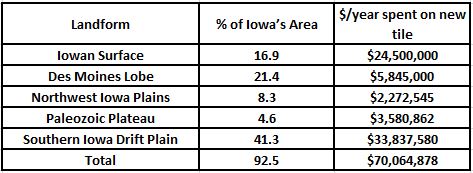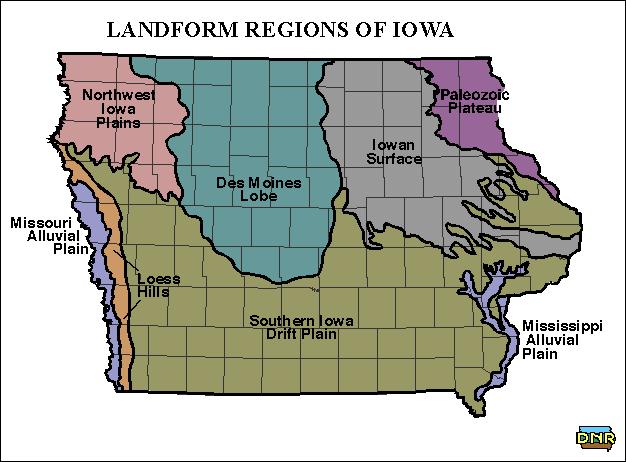
People ask me how long it takes to write these. The answer is about 1 hour for writing and 1 hour for editing. It’s usually done inside my head before I start typing. Getting the idea is another matter; that’s not so easy.
I do have ideas lined up but most aren’t ready to be written, and if I tried, the whole thing would be a mess. Over the past week, no writable ideas came to me until yesterday, when a young fellow named Jeren Wade Glosser walked into my office.
Jeren is a wrestler for the University of Iowa. Besides being a guy who looks like he could handle a situation (ask your uncle if you don’t know what I mean by that), he’s also an environmental science major who has done some great work for Larry and Keith mapping new tile drainage using aerial imagery as part of the Iowa Watershed Approach project. His work has contributed to two previous essays (By the Numbers, Follow the Water).
If you don’t know, tile drainage is a method whereby the water table is lowered in farmed fields using a network of porous pipes that then discharge to the stream network. It’s a big reason why our streams have elevated nitrate concentrations (1), Iowa’s most talked about water quality problem.
Jeren has completed his analysis for these watersheds: Middle Cedar, North Raccoon, English River, Upper Iowa River (NE Iowa), Clear Creek (Iowa River tributary), and the Upper Wapsipinicon River. As part of this, he estimated the dollar amount spent on installing new drain tile, looking at three individual years for each watershed. His work estimated a range of values and I show the average of this range in Table 1 below.

You can see that the amounts being spent are increasing, in some cases very rapidly. Considering the 2016 values and the area of the Iowa landforms where they lie (Iowan Surface, Paleozoic Plateau, Des Moines Lobe, Southern Iowa Drift Plain), I did some of my own estimating on how much is being spent annually on new drain tile in each of the landforms. This is shown in Table 2 below. Because of its similarity to the Des Moines Lobe, I also estimated the amount for the Northwest Iowa Plains based on Jeren’s North Raccoon watershed figure.

Admittedly, I like putting things into perspective and so let’s do that. My observation is that cover crops are the practice that holds the most promise for reducing nitrate pollution in the existing system, and as such they are promoted most frequently by agencies and conservation groups, relative to other practices. If I generously assume 1 million Iowa crop acres where cover crops have been implemented (the high end of estimates, but reasonable) and a $30/acre cost for the practice, then $30 million per year is being spent for this practice, and a fair amount of this amount is from public cost share. The $70 million spent per year on tile would pay for another 2.3 million acres of cover crops. It would also pay for 280 CREP-style constructed wetlands (currently we have about 90).

Let’s look at Iowa Senate File 512, passed in 2018 and signed by the governor. It provides $282 million over 20 years ($14 million per year on average) for water quality projects. On a per year basis, this is only 20% of the money we are spending on new drainage tile installation.
So the obvious punch line here is that while we are spending some millions (public and private money) to take down the stream nitrate problem, we are also suffering a reversal by spending many millions (private money) to make the problem worse. Call me a crank if you must, but I just don’t think we have thought these things through very well, and it’s abundantly clear where our priorities lie.
Back to Jeren. He hails from the tiny southeast Iowa town of Blakesburg, population 296. As coincidence would have it, Blakesburg is the birthplace of my maternal grandmother. Both her and her husband’s ancestors crossed the river into Iowa around 1840 (I’m more certain about my grandfather’s story than hers), not long after the territory was opened up for European settlement by the Black Hawk Purchase, which followed the defeat of the Sauk chief of the same name. Black Hawk died in Davis County, Iowa, just south of Blakesburg, and may be buried in a cemetery near Selma, Iowa.
What little I remember about Blakesburg relates to my great uncle who farmed in the vicinity. He was taller and had thicker eye glasses than perhaps anybody I can recall from my childhood. He amassed a museum-quality collection of Native American artifacts, these unearthed while plowing. His nephew (my uncle), who sometimes rode along in the tractor with him, still has these pieces created and used by the people we displaced.
_________________________________________________________
Postscript
My colleague Antonio Arenas has been developing some clever animations and I thought I would share them with you here. This one (link) shows Raccoon River accumulated nitrate loading over the past 5 years. You can see that thus far in 2019, levels are 2nd-lowest of the past five years.
Antonio has also created some clever timeline illustrations (link) of the historic Missouri and Mississippi River flooding that is ongoing in our state. Besides being a very smart fellow, like Jeren, Antonio also is the sort of guy that looks like he is capable of handling a situation.
Phil Kerr of the Iowa Geological Survey also helped with this essay.
- Baker, J. L., Campbell, K. L., Johnson, H. P., & Hanway, J. J. (1975). Nitrate, Phosphorus, and Sulfate in Subsurface Drainage Water 1. Journal of Environmental Quality, 4(3), 406-412